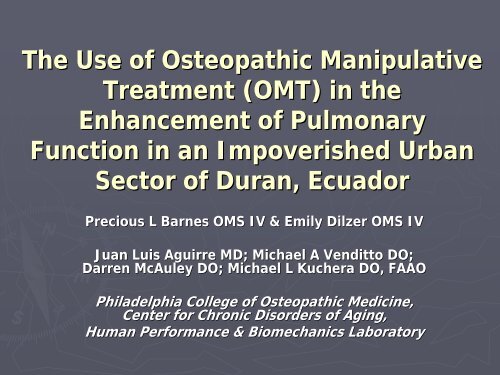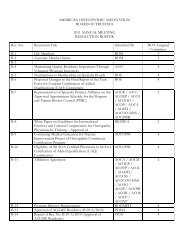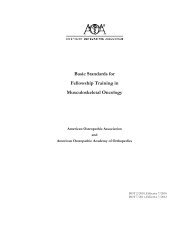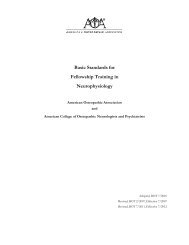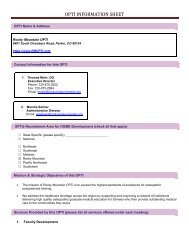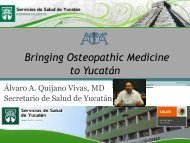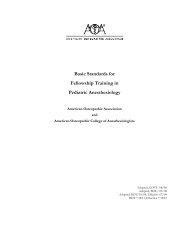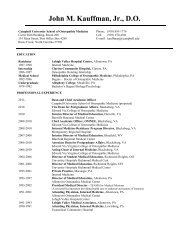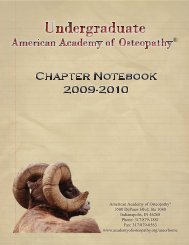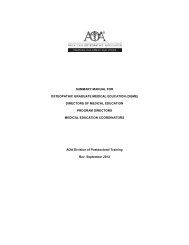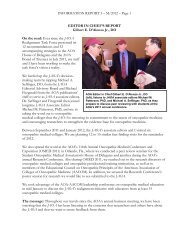The Use of Osteopathic Manipulative Treatment (OMT) - American ...
The Use of Osteopathic Manipulative Treatment (OMT) - American ...
The Use of Osteopathic Manipulative Treatment (OMT) - American ...
You also want an ePaper? Increase the reach of your titles
YUMPU automatically turns print PDFs into web optimized ePapers that Google loves.
<strong>The</strong> <strong>Use</strong> <strong>of</strong> <strong>Osteopathic</strong> <strong>Manipulative</strong><br />
<strong>Treatment</strong> (<strong>OMT</strong>) in the<br />
Enhancement <strong>of</strong> Pulmonary<br />
Function in an Impoverished Urban<br />
Sector <strong>of</strong> Duran, Ecuador<br />
Precious L Barnes OMS IV & Emily Dilzer OMS IV<br />
Juan Luis Aguirre MD; Michael A Venditto DO;<br />
Darren McAuley DO; Michael L Kuchera DO, FAAO<br />
Philadelphia College <strong>of</strong> <strong>Osteopathic</strong> Medicine,<br />
Center for Chronic Disorders <strong>of</strong> Aging,<br />
Human Performance & Biomechanics Laboratory
Background<br />
► About 80% <strong>of</strong> Ecuadorians go<br />
without quality or routine<br />
health care.[i]<br />
► Duran is the 3 rd largest city in<br />
Ecuador and is home to some<br />
<strong>of</strong> the poorest Ecuadorians.<br />
► Many homes <strong>of</strong> Duran feature<br />
hard packed dirt floors, while<br />
dusty streets and polluted air<br />
place unwanted strain on the<br />
lungs.<br />
Duran, Ecuador
Background<br />
► Standard approaches to respiratory disease prevention<br />
focuses on providing clean water and air<br />
► <strong>The</strong> osteopathic standard also emphasizes adding the<br />
RESPIRATORY-CIRCULATORY MODEL to enhance host<br />
response against pulmonary related disease.<br />
► If the environment is not conducive to healing and the<br />
body is already compromised, an individual’s s impaired<br />
medical condition can be exacerbated.<br />
• If the ribs are restricted, the breathing will then be reduced.<br />
• If the diaphragm does not move well because rib motion is<br />
constrained, lymphatic drainage will also be compromised.<br />
► Inefficient lymphatic flow can also result in acute or<br />
chronic respiratory infections, or other chronic<br />
respiratory diseases such as asthma.
Background<br />
► Studies show that the use <strong>of</strong> <strong>OMT</strong> to treat patients<br />
in the 1918 Flu Epidemic cut mortality rates to<br />
0.25%, as compared with 5% for those not<br />
treated with <strong>OMT</strong>.[i]<br />
► Wheatly found that rib raising improved the<br />
pulmonary function <strong>of</strong> all patients, but most<br />
significantly the asthmatic patient.[ii]<br />
► Bradbury also found that <strong>OMT</strong> to the diaphragm<br />
decreases the residual volume <strong>of</strong> the lungs,[iii]<br />
thereby enhancing overall lung function, a key<br />
component to maintaining homeostasis.
Hypothesis<br />
►We We hypothesized that a single treatment<br />
with <strong>OMT</strong> would likely<br />
• Improve Pulmonary Function Tests<br />
• Decrease somatic changes that result from<br />
pulmonary dysfunction<br />
• Enhance patient’s s subjective assessment <strong>of</strong><br />
breathing quality.
Materials & Methods:<br />
MATERIALS AND METHODS:<br />
►Patients Patients received routine H&P<br />
►A A thorough <strong>Osteopathic</strong> Structural Exam<br />
(performed by an osteopathic medical<br />
student or resident)<br />
►Pulmonary function tests pre and post <strong>OMT</strong><br />
►Questionnaires from the World Bank<br />
pertaining to environmental health risks that<br />
can be modified to improve overall health.
ENVIRONMENTAL RISK<br />
Ventilation and gas use:<br />
-No ventilation (i.e. no windows)<br />
-Gas<br />
•Unclean fuel<br />
•Stove in poor condition<br />
Household location:<br />
-House located on a dirt road (exposed to<br />
dust on a daily basis)<br />
-House located in a swampy area (exposed<br />
to mold on a daily basis)<br />
*May be both categories<br />
Living Conditions:<br />
-More than three people per bed<br />
-More than five people per bed<br />
Children:<br />
-1 Child in primary school/daycare<br />
-2 or more Children in primary school/<br />
daycare<br />
Transportation:<br />
-Walk or ride bike on dusty road to work,<br />
school, store, etc<br />
-Take a bus, cab or driven by friend<br />
Smoking:<br />
-Patient smokes<br />
-Other members <strong>of</strong> household smoke<br />
TOTAL POINTS:<br />
Add 2 points<br />
Add 1 point for each<br />
Add 2 points<br />
Add 2 points<br />
Add 1 point<br />
Add 2 points<br />
Add 1 point<br />
Add 2 points<br />
Add 2 points<br />
Add 0 points<br />
Add 2 points<br />
Add 1 point<br />
Point system from<br />
the World Bank for<br />
determining<br />
environmentally-<br />
linked pulmonary<br />
health risks<br />
Possible points: 0-16<br />
Low risk: 0-5<br />
Medium risk: 6-10<br />
High risk: 11-16
Point system from the World Bank for<br />
determining environmentally-linked linked pulmonary<br />
health risks<br />
ENVIRONMENTAL RISK<br />
Ventilation and gas use:<br />
-No ventilation (i.e. no windows)<br />
-Gas<br />
•Unclean fuel<br />
•Stove in poor condition<br />
Household location:<br />
-House located on a dirt road (exposed to<br />
dust on a daily basis)<br />
-House located in a swampy area (exposed<br />
to mold on a daily basis)<br />
*May be both categories<br />
-Total Points<br />
TOTAL POINTS:<br />
Add 2 points<br />
Add 1 point for each<br />
Add 2 points<br />
Add 2 points<br />
4 point = Low Risk
Pulmonary <strong>OMT</strong> Exam<br />
► Quality <strong>of</strong> respiration: if pt was not breathing down to<br />
pubic symphysis and/or accessory muscle use = ↓ quality<br />
► Chapman’s s points<br />
• sympathetics for lungs (T1-T6);<br />
T6);<br />
• intercostal spaces 2-42<br />
4 (lungs),<br />
• C3-C5 C5 (phrenic nerve innervations),<br />
• Zink pattern (to assess possible lymphatic flow obstruction),<br />
• rib cage/sternal was palpated for somatic dysfunction and visual or<br />
palpable evidence <strong>of</strong> tissue texture change.<br />
► Standard protocol for <strong>Osteopathic</strong> treatment <strong>of</strong> respiratory<br />
patients at PCOM routinely focuses on correcting the Zink<br />
pattern, balancing parasympathetics and sympathetics,<br />
maximizing the thoraco-abdomino<br />
abdomino-pelvic<br />
respiratory/circulatory pump, and augmenting physiologic<br />
pumps by rib raising, pectoral traction, and Miller or pedal<br />
pump.
Results<br />
► A total <strong>of</strong> 21 charts met the inclusion criteria for this study,<br />
but following chart analysis, five patient charts were<br />
discounted due to faulty pulmonary function measurement.<br />
<strong>The</strong>refore a total <strong>of</strong> 16 charts were used to assess the<br />
evaluation <strong>of</strong> <strong>OMT</strong> on pulmonary function testing, and a<br />
total <strong>of</strong> 21 charts were used for the evaluation <strong>of</strong> somatic<br />
changes relating to pulmonary dysfunction.<br />
► Environmental risk calculations showed:<br />
• SD patients evaluation = 3 low-risk, 15 medium-risk, and, 3 high-risk<br />
• PFT patients evaluation = 2 low-risk, 12 medium-risk, and 2 high-risk<br />
► All patients with pulmonary complaints demonstrated some<br />
level <strong>of</strong> SD that corresponded to pulmonary dysfunction.<br />
► <strong>The</strong> high-risk patients had the greatest number <strong>of</strong> somatic<br />
dysfunctions.
7<br />
FVC<br />
Pre and Post <strong>OMT</strong><br />
6<br />
5<br />
PFT Values<br />
4<br />
3<br />
PRE <strong>OMT</strong> FVC<br />
POST <strong>OMT</strong> FVC<br />
2<br />
1<br />
0<br />
11 8 1 2 5 6 7 9 10 13 14 15 16 17 19 20 21<br />
High EnviornmentalRisk<br />
Low Enviornmental Risk<br />
Medium Enviornmental Risk Group<br />
Group<br />
Group<br />
Subject Number<br />
► Significant improvement in 5 patients<br />
• 1, 10, 14, 19, 20<br />
► Decrease in 2 patients<br />
• 15, 21
4.5<br />
FEV 1<br />
Pre and Post <strong>OMT</strong><br />
4<br />
3.5<br />
3<br />
PFT Values<br />
2.5<br />
2<br />
PRE <strong>OMT</strong> FEV1<br />
POST <strong>OMT</strong> FEV1<br />
1.5<br />
1<br />
0.5<br />
0<br />
11 8 1 2 5 6 7 9 10 13 14 15 16 17 19 20 21<br />
High EnviornmentalRisk<br />
Medium Enviornmental Risk Group<br />
Low Enviornmental Risk<br />
Group<br />
Group<br />
Subject Number<br />
► Significant improvement in 4 patients<br />
• 10, 14, 19, 20<br />
► Decrease in 3 other patients<br />
• 1, 13, 15
Results<br />
► Only 5 <strong>of</strong> 16 patients demonstrated significant<br />
improvement in pulmonary function testing<br />
following <strong>OMT</strong><br />
► 20 <strong>of</strong> 21 total patients noted a significant<br />
subjective overall improvement in how well they<br />
felt and in their ability to breathe.<br />
► <strong>OMT</strong> corrected SD interpreted as Chapman’s<br />
reflexes in 21 <strong>of</strong> 21 cases<br />
► A trend suggesting restrictive processes respond<br />
better to <strong>OMT</strong><br />
► Those with significant improvement in PFT’s s were<br />
all under 20 years old
Discussion<br />
►Of the 5 patients who demonstrated<br />
improvement,<br />
• 1= low risk & 4=medium risk.<br />
• No high-risk patients demonstrated<br />
improvement.<br />
►This This may suggest that more treatments are needed<br />
in high-risk patients as a result <strong>of</strong> increased exposure<br />
to environmental pulmonary hazards.
Discussion<br />
► Patients with normal spirometry varied in<br />
presentation but had a variety <strong>of</strong> pulmonary SD.<br />
► <strong>The</strong> majority <strong>of</strong> these patients presented with a<br />
cough or shortness <strong>of</strong> breath along with<br />
corresponding SD between C3-C5.<br />
C5.<br />
► Although the chart review did not indicate a direct<br />
relationship between restoration <strong>of</strong> the Zink<br />
pattern and immediate improvement <strong>of</strong> PFT's, the<br />
Zink pattern normalized in those with improved<br />
PFT's<br />
• Which could imply that pulmonary function may improve<br />
by removing lymphatic flow obstructions, in conjunction<br />
with autonomic balancing, biomechanical restoration,<br />
and lymphatic treatments
Conclusion<br />
► Chart analysis reveals that pulmonary<br />
complaints are strongly linked to somatic<br />
dysfunction (SD) that manifests as<br />
• Pulmonary Chapman’s s points<br />
• Decreased quality <strong>of</strong> respiration (failure <strong>of</strong> the breath<br />
to travel to the pubes)<br />
• Uncompensated Zink patterns (representing blocked<br />
lymphatic flow)<br />
• Thoracic cage dysfunctions (which may lead to a<br />
restrictive or obstructive pattern depending on if the<br />
ribs are inhaled or exhaled)
Conclusion<br />
►It is possible that more subjects may be<br />
supportive <strong>of</strong> a trend indicating that a single<br />
<strong>OMT</strong> session in a younger, non-obstructed<br />
obstructed<br />
population will improve pulmonary function<br />
more so than in older populations.<br />
►More More tests are required to determine if the<br />
drop in FEV1 is temporary due to fatigue or<br />
is it a physiological change.
Conclusion<br />
►All people with pulmonary complaints had<br />
some form <strong>of</strong> pulmonary-related related somatic<br />
dysfunction.<br />
►This This data adds to the literature to support<br />
the use <strong>of</strong> osteopathic evaluation in the<br />
treatment and management <strong>of</strong> patients with<br />
pulmonary dysfunctions.
Conclusion<br />
►<strong>The</strong> <strong>The</strong> <strong>Osteopathic</strong> Skills that we have learned<br />
has afforded us this unique opportunity to<br />
provide care to the people <strong>of</strong> Duran as well<br />
as share this information our host doctors.<br />
► <strong>The</strong> people <strong>of</strong> Duran love <strong>OMT</strong><br />
►<strong>The</strong> <strong>The</strong> doctor has requested that we teach<br />
them more techniques to improve their<br />
practice.
Acknowledgment<br />
SOMA<br />
Juan Luis Aguirre MD<br />
Michael A Venditto DO<br />
Darren McAuley DO<br />
Michael L Kuchera DO, FAAO<br />
Nicholas Bower DO<br />
Matthew Montgomery DO<br />
PGY-1<br />
Physicians For Humanity for<br />
making this research<br />
project possible.
REFERENCES<br />
►<br />
[1] Koerning, Felissa. . Feb 2007. Global Health LOI Narrative Submission Form, Bill and d Melinda Gates Foundation [grant<br />
application]. Philadelphia (PA): Physicians For Humanity.<br />
► [1] [PAHO] Pan <strong>American</strong> Health Organization. 1998. Health in the t<br />
Americas. Vol. II: Ecuador. p. 241.<br />
http://www.paho.org/english/HIA1998/Ecuador.pdf. (2008 Jan 2).<br />
► [1] Shyamsundar, Priya. . Jan 2002. <strong>The</strong> World Bank Environment Department: Environmental Economic Series, Paper NO. 84:<br />
Poverty- Environment Indicators. http://siteresources.worldbank.org/INTECA/Resources/ch1-poverty.pdf<br />
poverty.pdf. . (2008 Jan 2).<br />
► [1] Preamble to the Constitution <strong>of</strong> the World Health Organization n as adopted by the International Health Conference, New York,<br />
19-22 June, 1946; signed on 22 July 1946 by the representatives <strong>of</strong> 61 States (Official Records <strong>of</strong> the World Health Organization,<br />
no. 2, p. 100) and entered into force on 7 April 1948. http://www.who.int/about/definition/en/print.html<br />
(2009, Jan 15th)<br />
► [1] Shyamsundar, Priya. . Jan 2002.<br />
► [1] [WHO]World[<br />
Health Organization. 2006. Mortality Country Fact Sheet: Causes <strong>of</strong> death in children under 5.<br />
http://www.who.int/whosis/mort/pr<strong>of</strong>iles/mort_amro_ecu_ecuador.pdf. (2009 Jan 2nd).<br />
► [1] [WHO]World[<br />
Health Organization. 2006. Mortality Country Fact Sheet: Causes <strong>of</strong> death in children under 5.<br />
http://www.who.int/whosis/mort/pr<strong>of</strong>iles/mort_amro_ecu_ecuador.pdf.<br />
► [1] Ooi GL, Phua KH. Urbanization and Slum Formation. Journal <strong>of</strong> Urban Health Bulletin <strong>of</strong> the New York Academy <strong>of</strong> Medicine.<br />
2007; 84: i27-i34.<br />
i34.<br />
► [1] Koerning, Felissa. . Feb 2007.<br />
► [1] Koerning, , February 2007.<br />
► [1] Paulus, , Stephen. 2006, Winter. Concerning Osteopathy: Vital Motions and Material Forms. Inter Linea, 14.<br />
http://www.interlinea.org<br />
www.interlinea.org/<br />
► [1] Bradbury, Joseph Aaron. 2004. <strong>The</strong> effect <strong>of</strong> osteopathic manipulative medicine on pulmonary function and lung volumes in<br />
healthy adults. [dissertation]. Forth Worth (TX): University <strong>of</strong> North Texas Health Science Center at Forth Worth, United States.<br />
Available from ProQuest Digital Dissertations database; publication No. AAT 1433825).<br />
► [1] Bradbury, 2004. p 6-7. 6<br />
► [1] D’Alonzo<br />
G, Karachman, , S. Pulmonology. . In: Ward R., editor. Foundations for <strong>Osteopathic</strong> Medicine. 2nd ed.p 505-506.<br />
506.<br />
► [1]. . Kuchera M, Kuchera W. 1994. <strong>Osteopathic</strong> Considerations in Systemic Dysfunction: <strong>Osteopathic</strong> Considerations in the Lower<br />
Respiratory Disorders. Columbus (OH): Greyden Press. p. 25-30.<br />
► [1] Undefined. (n.d(<br />
n.d.). .). <strong>The</strong> Cranial Academy. In Philosophical Foundations <strong>of</strong> Osteopathy.<br />
thy.<br />
http://www.cranialacademy.com/philosophy.html<br />
www.cranialacademy.com/philosophy.html. . (2009 Jan 2).<br />
► [1] World Health Organization. 2006. Mortality Country Fact Sheet: Causes <strong>of</strong> death in children under 5.<br />
http://www.who.int/whosis/mort/pr<strong>of</strong>iles/mort_amro_ecu_ecuador.pdf.<br />
► [1] World Health Organization. 2006. Mortality Country Fact Sheet: Top ten causes <strong>of</strong> death, all ages. Retrieved January 1,<br />
2008, from http://www.who.int/whosis/mort/pr<strong>of</strong>iles/mort_amro_ecu_ecuador.pdf.<br />
► [1] Bradbury, Joseph Aaron. 2004. <strong>The</strong> effect <strong>of</strong> osteopathic manipulative medicine on pulmonary function and lung volumes in<br />
healthy adults. [dissertation]. Forth Worth (TX): University <strong>of</strong> North Texas Health Science Center at Forth Worth, United States.<br />
Available from ProQuest Digital Dissertations database; publication No. AAT 1433825).<br />
► [1] Bradbury, 2004. p. 4.<br />
► [1] Bradbury, 2004. p. 4-5. 4<br />
► [1] Enright, , Paul. 2008. Office Spirometry. UpTo Date. http://www.uptodate.com<br />
www.uptodate.com. . p. 1-9. 1


